Creating the right kind of marketing content is difficult. If it’s not, then you’re probably not thinking hard enough about it. And when you do that you might just be making a bit of noise with not much effect.
But content planning doesn’t have to be as hard as many businesses seem to find it.
In the B2B world, content projects get stalled and websites miss their mark for a simple reason: there’s no guiding strategy. Your strategy doesn’t have to be a vast, complex and expensively produced document full of marketing jargon. It could be a diagram. Use your strategy to map the relationship between the value you offer and the value your prospects are looking for. And make sure you include the channels best able to reach those prospects.
The strategy starts with your target customers and knowing where your best opportunities lie. You can then package your offer to make it more attractive and develop your key marketing themes. Market research will certainly help you focus.
What Do Customers Care About?
So where do things start to go off track? Smaller B2B companies without significant marketing resources or experience rarely have a content or marketing strategy. Instead, they get tied up with their service or product. The details of services and products matter a great deal to you. For your prospects, they hold less value.
Web content, blogs, videos, emails become all about the product or service. Coming up with new content ideas becomes a game of: ‘we could do something about this, that might interest people.’ And ultimately there’s no traction because there’s no value to the reader.
The Content Value Model
If that sounds familiar, here’s a simple model that might help you think more strategically about your marketing content.

The layers in this model are important. The idea is to work from the outside in, rather than from the centre out, which is what you might currently be doing.
At the core of every business is the essence of ‘you.’ This is all about what you believe and the sense of values you bring to customer relationships. This is what drives your business and shapes how you do things.
This core helps your people make the right decisions and guides their behaviour. But here’s the thing, it’s only relevant to prospects when it relates to how you meet their needs. Otherwise, they don’t really care.
Wrapped around that you have the practicalities: what you do and how you do it. Judging by my LinkedIn feed ‘what you do’ is where the vast majority of B2B content is driven from – it certainly drives most websites.
But based on your values you will do things differently from your competitors. These points of difference – and why they make a meaningful difference to your prospects – are rarely made clear.
The outer – and most important – layer is what your customers get. In other words, how you fulfill their needs – both practical and emotional. This is where your content strategy should start.
I know what you’re thinking, in the B2B world there are several people involved in the buying decision. They all have their own motivation. No problem – just fit a different outer layer around the model to suit each type of buyer.
Defining Customer Needs
Practical needs are easier to understand. Any B2B company with a hope of staying in business ought to be able to list them easily.
Emotional needs should be central to your market positioning. They are less obvious. But B2B buyers are people. Their decisions are driven by emotional factors. These could be a need for status or prestige, survival, security, being included, intellectual curiosity and all sorts of other things that are not strictly rational. Not being blamed for a decision is a common one in the B2B world.
They also want an easy life and to deal with people that will be easy (and maybe fun) to work with.
This is the space where you really start to engage people. And it’s a well you can draw from as often as you like for content ideas. People never get tired of hearing about themselves.
Planning Your Website With a Content Value Model
One big advantage you might find when you use a content value model like the one above to plan your website content is that you’ll probably need less of it. A lot of the detail about what you do is suddenly irrelevant. There’ll be fewer pages and a simpler journey through to the action you want prospects to take.
Your prospects will be delighted too. No more boring detail – just wall-to-wall relevance that helps them make a decision. Happy days!
The thread that should run through all of your content should start with customers – what they want and what they get. If you then lead them down through the layers of your content value model you are also drawing them further into your sales funnel. They can see credible solutions to their problems, and an organisation they can trust.
Find Your Brand Voice
Starting with your customers will also help you find the right brand voice. You are talking to them and about them. You are sounding like a human, rather than a corporate entity.
Relate what prospects need most to the way you deliver your service. Sprinkle in the values that drive all of that and you have a reason for somebody to engage with your content. You also create value for your business.
But you have to engage prospects first by talking about something they genuinely want and value. And that means looking at your market a bit more strategically.
If you’d like some help with taking a more strategic approach to B2B marketing content, or you just want somebody to write better copy, get in touch.
Photo by JESHOOTS.COM on Unsplash

